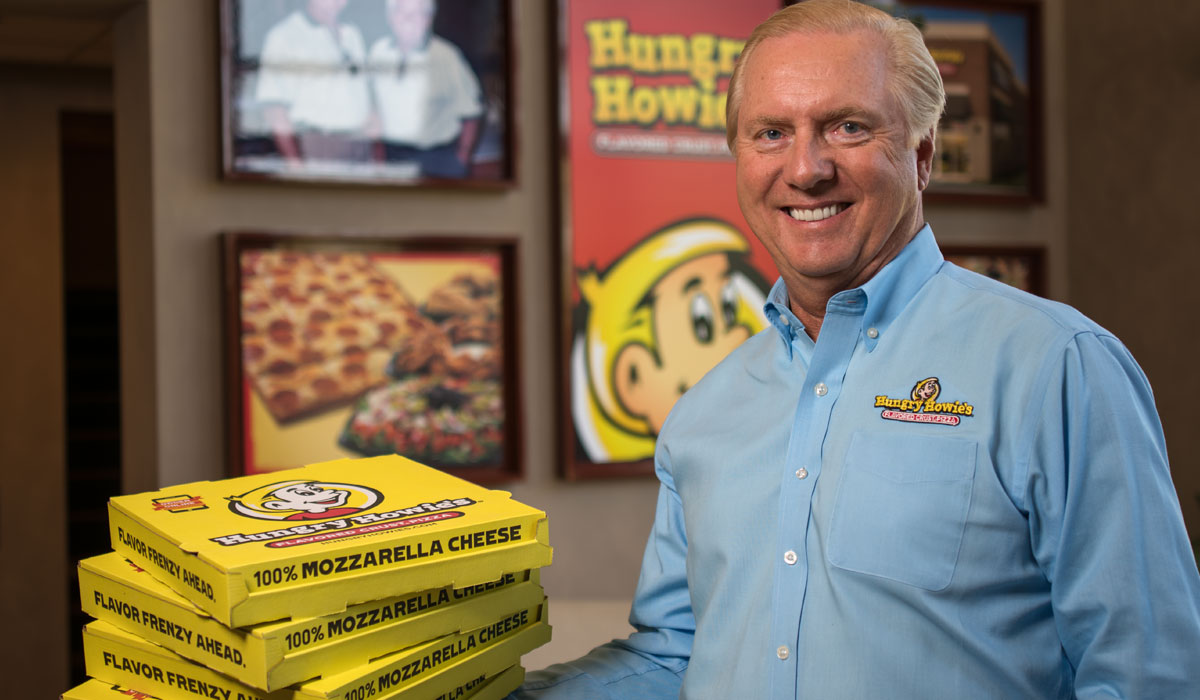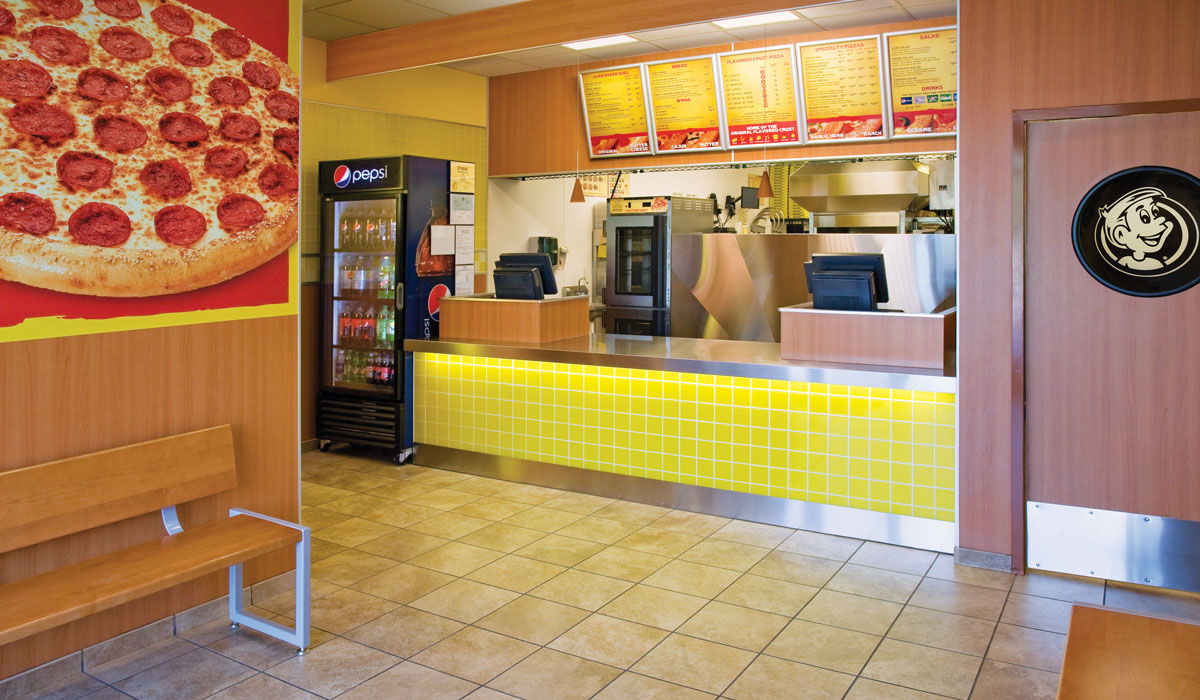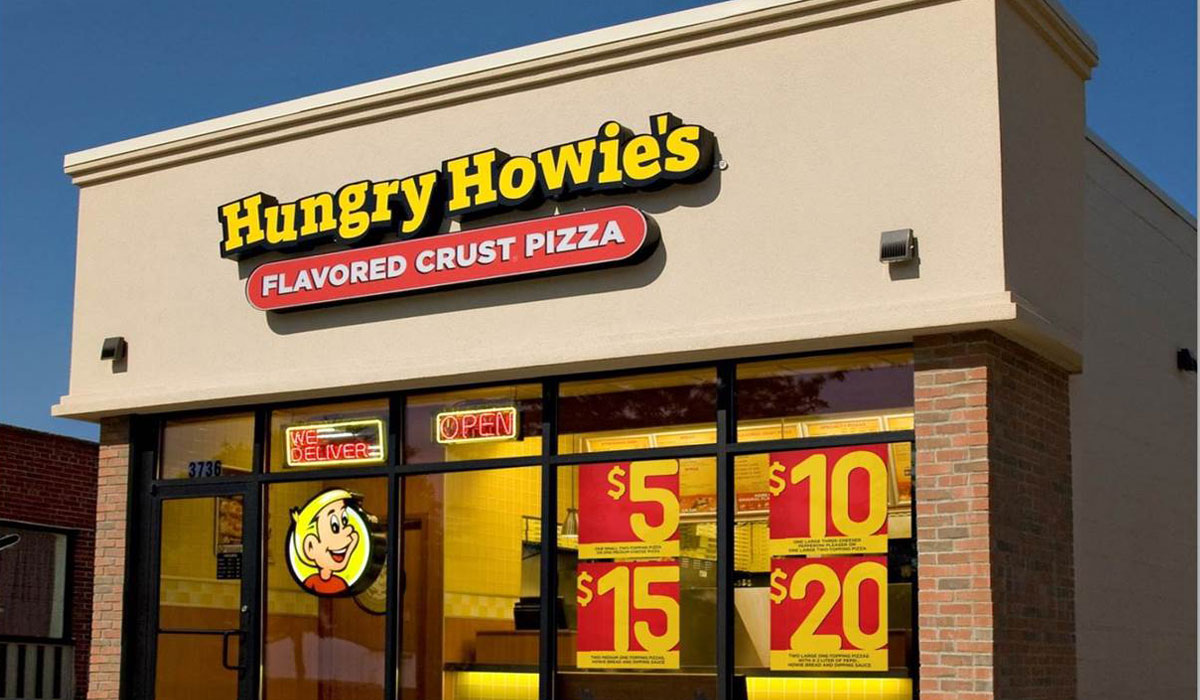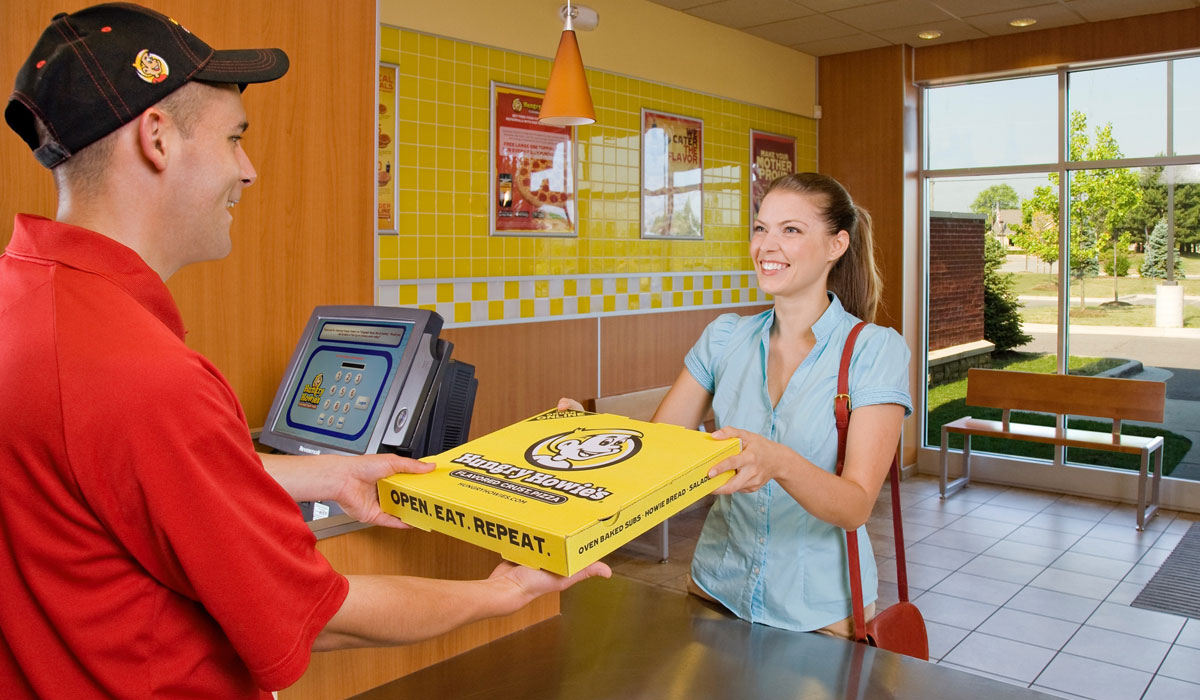In 2016, Hungry Howie’s took its first real stab at digital marketing. Customers who purchased a large round pizza with one or more toppings could buy another for 29 cents. The Leap Year deal ran from February 29 through March 1 and pretty much wiped out Hungry Howie’s supply. By 7 or 8 that night, the lion’s share of locations ran out of food.
Generally, Hungry Howie’s marketed like most pizza chains, especially those in the challenger space: It printed coupons and shipped them to mailboxes within a defined radius of each restaurant. Steve Jackson, Hungry Howie’s chief executive, says those campaigns were typically measured by single-digit percentage-point success. Maybe 10 percent if “you just knock it out of the park.”
This first, leap of faith, off-the-high-board dive into digital turned out to be an eye-opener for a variety of reasons, and not all of them positive. Franchisees were upset. Customers irate. “We gave poor service,” Jackson says. “And that’s never acceptable.”
“There was a cycle of emotions that took place.”
The other side of the spectrum? Hungry Howie’s boosted its day-over-day business 112 percent. Jackson says they never expected it. Firstly, though, Hungry Howie’s scrambled. Apologized. Made sure distribution centers refilled supplies. But then Jackson and the brand’s executives could pause, consider the ramifications, and reflect.
“Honestly, a couple of days later the leadership walked into our conference room and we had sniggers on our face,” he says. “Because we were like, what did we just learn?”
Simply, in the four-plus decades of Hungry Howie’s history, no marketing campaign came even close.
“We stuck our toe in the water and almost drowned that first time,” Jackson says. “But it was a learning experience. And all we’ve done since is try to tweak that learning experience to better understand how to do it in a more manageable way—to still be able to service our customers with product and service they deserve.”
This anecdote illustrates Hungry Howie’s approach to the rapidly shifting restaurant landscape, Jackson says. An established brand, but one that also fosters a culture of change.
From a top-line perspective, Hungry Howie’s put together its 35th consecutive quarter, or nearly ninth straight year, of same-store sales growth in 2018. Comps rose 5.15 percent versus 2017 at the 550-unit chain. It also inked multi-unit deals in Arkansas and Utah and plans to expand in Arizona, Nevada, Texas, and Tennessee this coming year.
Through it all, Jackson has witnessed every lifecycle and evolution of Hungry Howie’s. And that’s not an exaggeration. He started delivering pizzas for founder Jim Hearn 42 years ago. He was working the line at Ford and decided to quit college ahead of his senior year and join the company. Jackson opened the second Hungry Howie’s store and hasn’t looked back since.

Marketing for the modern pizza chain
Rob Elliott, Hungry Howie’s EVP of marketing, likes to say marketing and advertising has changed more in the last five years than in the previous 50. From digital to lapsed customer programs to big data, it’s completely changed the way restaurants reach guests, and vice versa.
In the pizza industry especially, value is where the marketplace lives. “Our advertising has to be very aggressive and strategic,” Jackson says. “Because the dollars have to be focused in the right areas. What was right five, 10 years ago, it’s not right anymore.”
And when you’re a brand with this wealth of equity, and one that lives in smaller, rural communities mostly, some old methods linger. Jackson says they still put coupons in the mailbox “because we hate to throw the baby out with the bathwater.” However, Hungry Howie’s recently decided to cut a significant percentage of its marketing for 2019 and reallocate the print to more digital.
The key in 2019: A fully integrated marketing plan that includes every aspect, Jackson says.
What you don’t want to do, though, is let past efforts stick to the calendar like peeling wallpaper. “We have to keep reevaluating those percentages of what goes where, and that’s what’s going to keep us relevant,” Jackson says.
“The one thing I’m most proud of,” he adds, “is we’ve really, I think, created a culture around change, and we have franchisees open minded enough to test, try, and react according to the way we feel the marketplace is calling for.”
“I kind of sit back and think, holy smokes, how can it be 45 years? But it is an affirmation that our business model is sustainable and proven. And we’re also able to change with changing conditions over an extremely long period of time.” — Steve Jackson, Hungry Howie’s CEO.

Being nimble, and what that entails
In the past three years, Hungry Howie’s has moved all of its stores to the same point-of-sale system. That might not be the sexiest initiative but it’s been a game-changer. Hungry Howie’s standardized them so it knows exactly what’s happening on a real-time basis. And it can make decisions accordingly.
This plays into the digital element as well. If Hungry Howie’s saw a trend it wanted to jump on before, the process would unfold like this: A print campaign could be 60–90 days out by the time artwork showed up and the coupon selections and proofs went into the mall.
Now? Jackson calls the office and says, “Hey, tomorrow, let’s run a large pizza for $1 with a purchase of $15.”
Hungry Howie’s has about 4 million people in its database currently, Jackson says. So with a push of a button and those 4 million people loaded in, Hungry Howie’s hits every single market within a certain area and is digitally able to respond to those guests within 24 hours.
There is also something to be said about being, relatively speaking, a smaller brand compared to the pizza giants. Back in the day, 20, 30 years ago, Jackson says, the goal was to get to the size where you could do national marketing—national market buys instead of regional market buys for broadcast, TV, cable, and so forth. You essentially had to reach 1,000-plus locations before you were even close to make that call.
“So sometimes your non-broadcast markets only relied on print,” Jackson says. “And they didn’t have that opportunity. Well, now, with digital, we literally can do these mini campaigns within a particular market area where those customers could see the same TV commercial that we might run in our broadcast markets.”
That strategy allows Hungry Howie’s to give off the impression of a much-larger national brand. In smaller markets without the budget, it can still take top-dollar productions and send them out to single-store operators that might not have the spend capabilities, but still want the exposure.

Making sense of big data
It’s one thing to have all this customer information and another to process it. And pizza chains, arguably, have the most. If a diner visits a burger brand, for example, they’re probably walking in, ordering, and walking out. Perhaps they’re a loyalty member and the restaurant gleans information to target with future incentives and other deals. In the case of pizza companies, however, especially those that operate mainly in the take-out and delivery space, fueled by digital, they know guests’ names. Where they live. Phone numbers. What they eat and how often they eat it. Currently, about 44 percent of Hungry Howie’s orders are online.
“We can work with that information pretty successfully to understand your buying habits and try to alter them, if we can, with digital promotions,” Jackson says.
Hungry Howie’s wrote all of its own enterprise reporting software internally. At 9 each morning, the leadership team receives a series of reports on single pages that tell them every metric that’s important to the company. Then they use Microsoft Power BI to sort through the results. If they have a wish list of questions, the program arranges the data in seconds.
Hungry Howie’s also works with a large data company in Los Angeles that downloads data points and presents it the way Jackson and the team want to use it.
Here are some of the things they look for and how they leverage the information.
A lapsed customer program is critical for many quick-serves. Hungry Howie’s can see if a customer falls out of the ordering cycle and then suggest an offer to get them back. If that continues, a better offer can be pulsed. After running through the cycle three or so times, Jackson says, the chain will go to a freebie deal.
Hungry Howie’s looks at daypart sales. Product mix. The top 10 marketing coupon responses of what took place that particular day. It views door times, as far as how long it takes to get the product to leave the store and the delivery system.
With social media, Hungry Howie’s is big on “natural posts,” where somebody will go in and order a pizza and take the imperfect shot. It’s all about natural communication and making sure those ties cut as seldom as possible, across the channel spectrum.
Rewards rewards
Howie Rewards just completed its second year. The brand implemented online ordering about a decade ago, Jackson says, but they’re constantly updating the platform to be more user friendly and to provide information. Getting the loyalty rewards program integrated was a natural and instrumental stage.
“We’re trying to incentivize them to sign up to be a rewards member,” Jackson says. “That’s what we’re trying to build right now.”
There’s no understating how valuable those contacts are. Every time Hungry Howie’s gets an email address, whether it’s a rewards member or new customer, it grows that 4 million-person base that serves as the lifeblood of its marketing efforts.
And here’s the straightforward reality of online ordering: Checks track higher, on average, across nearly every segment of foodservice.
The reason behind this changes by company, but for Hungry Howie’s it’s a rather simple phenomenon. When a customer calls into the restaurant, especially during peak times, the employee will likely rush them off the phone. That’s just the nature of the business, Jackson says. “You’re going to have a young person says, ‘OK is that all you want? Are you done? Are you done? Because they’re waiting to answer the next one,” Jackson says.
Hungry Howie’s put together its 35th consecutive quarter, or nearly ninth straight year, of same-store sales growth in 2018
Mobile ordering? The customer can sit there, take their time, look at pictures, and be presented with suggesting sells from Hungry Howie’s that don’t involve a countdown. Not only that, but you could assume many customers are more comfortable splurging when they’re interacting with a computer screen instead of a (perceived) judgmental person.
The challenges ahead
When asked about reaching 45 years, Jackson says, “I kind of sit back and think, holy smokes, how can it be 45 years? But it is an affirmation that our business model is sustainable and proven. And we’re also able to change with changing conditions over an extremely long period of time.”
Without much pause, Jackson says, challenge No. 1 is the low unemployment rate. It’s difficult when you’re in the minimum wage environment, like a pizza chain, to staff stores across a wide footprint without getting crushed by cost. And then, in turn, to provide the service you want despite the lack of help.
“We have to work to change that through employee satisfaction, or developing operational changes that would reduce needed man hours. I think a lot of that has been done over the years. I can remember when we first started we were slicing our own pepperoni and cutting our own cheeses and product. Now, a lot of that has been manufactured into our distribution centers.”
Hungry Howie’s still makes its dough fresh daily in each store, though. “And that’s a labor issue that adds time but we haven’t been willing to sacrifice that,” Jackson says.
Like many pizza brands, Hungry Howie’s is turning a very cautious eye to third-party delivery. “In our industry we’ve always delivered,” he says. “The pizza business is kind of like the delivery experts.”
Jackson sees the lure and benefit for other brands. It’s incremental sales and it’s a space they missed out on before. But the business model is challenging. Hungry Howie’s won’t use third-party, he adds, since it wants to own the data and control the experience. Yet hiring has become even tougher given the added driver competition.
In regards to the experience, Jackson worries that third party creates a murky trail of service. If the pizza shows up with one slice eaten, who’s responsible? If these companies start offering subscription, flat-price models that allow unlimited deliveries, what happens to margins? What happens when the lobby is packed with customers and third-party delivery drivers?
Regardless of where any of these topics progress, Jackson says, he believes Hungry Howie’s is well positioned to evolve as the trends do. “In another five years this might all have changed,” he says. “But we’ve proven we can change, too, and that’s why we’ve been so successful.”









